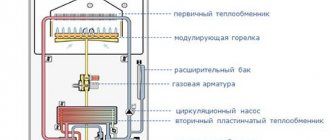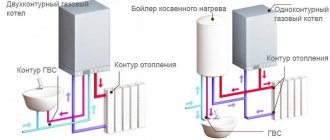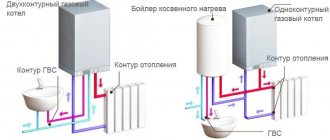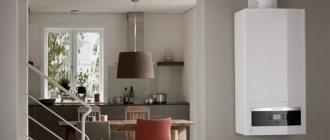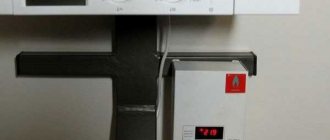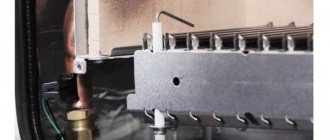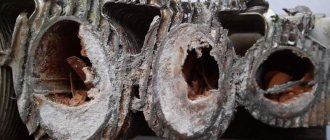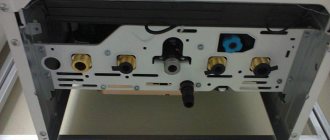Before connecting the boiler to the water supply system, turn off the water supply to the house.
A heating boiler is equipment in which the coolant (in most cases water) is heated to the required temperature and serves to heat or supply the room with hot water. In the modern world, the most popular source of thermal energy is natural gas. Consequently, devices that are capable of converting the internal energy of gas into heat, that is, gas boilers, are in great demand.
The simplest and cheapest option for this equipment is single-circuit gas heating boilers.
What it is?
A heating unit designed to heat the coolant and supply it to the heating circuit.
Wall-mounted models are mounted in a hinged manner on solid walls. Since the load on the supporting structures should not exceed a certain limit, wall-mounted models are not too large. Their power is limited to 40-50 kW, and the most popular are models from 15 to 16 kW, designed to heat rooms from 150 to 260 m2.
Such units have an attractive appearance, which allows them to be installed in kitchens or hallways. Installation is allowed only on sufficiently strong walls - a plasterboard partition cannot be a load-bearing surface. Separate premises are not required for them, but installing gas equipment in living rooms is prohibited by the rules. If the model is equipped with an open type burner, then installation is allowed only in rooms with a closing door (for example, in the kitchen).
Where are they used?
As a rule, single-circuit boilers are used only for space heating. They are installed in a gap in the heating circuit, where they become the starting and ending point of the circulation cycle.
Single-circuit boilers are used to heat different rooms:
- private houses;
- apartments;
- dacha;
- offices;
- workshops;
- shops, etc.
Initially, these units were used for heating auxiliary premises, workshops, shops, etc. However, practice of use has shown their noticeable advantage over dual-circuit models. If an indirect heating boiler is used in conjunction with a single-circuit boiler, the supply of hot water is more stable and does not affect the quality of heating of the house; the only condition is the installation of a unit whose power is 10-15% higher than the value required for a given area.
Such a power reserve is needed to service the boiler, and the size of this reserve is determined by the volume of the heater. For a family with large needs for hot water (for example, if there are small children), choosing a single-circuit boiler paired with a storage boiler is the best option, allowing you to use hot water in unlimited quantities.
When choosing a gas boiler model, you should determine your hot water needs. If they are small, you can buy a double-circuit boiler and save on buying a boiler. However, if the needs for domestic hot water are quite large, a single-circuit model would be the best solution.
Varieties of single-circuit circuits
With vertical wiring system
In this case, the coolant heated by the boiler rises through a vertically installed riser to the highest point of the heating network (into the attic or under the ceiling of the top floor), from where it then flows down, simultaneously heating the radiators located on each floor of the house.
Features of the design and operation of vertical heating circuits are as follows:
- the coolant can be moved naturally, without the use of electrical equipment;
- all sections of pipes should be laid with a slight slope towards the boiler in order to increase the intensity of water circulation and avoid the formation of air pockets;
- it is difficult to hide pipes in walls, since in this case you are unlikely to be able to maintain the slope;
- The system operates completely autonomously, so even in the event of an emergency power outage, you will not be left without heat.
Scheme of single-circuit heating with vertical wiring
With horizontal wiring system
The vertical riser is not mounted here. The main pipeline is laid along the floor or under it. If you decide to disguise pipes in a concrete screed, take care of their thermal insulation, otherwise quite significant heat losses cannot be avoided.
In addition, it is advisable to observe the slope in this case:
- firstly, the heating network will be able to operate (albeit less efficiently) during a power outage;
- secondly, when filling pipes with liquid, you will avoid the formation of air locks.
Single-circuit connection diagram with horizontal wiring
Device, design features
The design of a single-circuit boiler is a flow-through heater, the main element of which is a gas burner and a heat exchanger. They are combined into one unit, which allows creating conditions for maximum fuel combustion efficiency.
There are two burner designs:
- open (or atmospheric) . It was originally used on non-volatile models, but today it is also found on modern designs. Combustion air is taken directly from the room, which simplifies the operation of the burner, but makes it dependent on drafts, pressure changes and other external conditions;
- closed (turbocharged) . A turbofan is installed to supply air. The air flow is stabilized and does not depend on external factors. The smoke is also removed using a fan, which eliminates backdraft and other undesirable effects.
Boilers with a closed burner are much more convenient and safer. But they depend on the condition of the fan and require power supply.
What is the burner design in your gas heating boiler?
OpenClosed
There are models with different heat transfer methods:
- convection _ These are boilers equipped with conventional open or closed burners;
- condensation _ These are structures in which the coolant is heated in stages. First, primary heating is carried out using thermal energy obtained by condensing water vapor from flue gases. For this purpose, the boiler is equipped with a special condensation chamber. The second stage is conventional convection heating in a heat exchanger.
Expert opinion
Torsunov Pavel Maksimovich
Convection models are much more widespread than condensation models. They are able to work in any conditions and do not require any additional devices. Condensation models appeared relatively recently. They are only able to work under certain conditions.
For example, the difference between the temperature of indoor and outdoor air should not exceed 20°, otherwise the condensation process will become impossible. For Russia, where in the cold season the temperature difference is about 25°-35° or more, the use of such structures is useless. Considering that their cost is almost twice as high as that of conventional condensing models, the lack of demand is understandable.
How to calculate the required power
The thermal power of the boiler unit is selected so that it can cover all the heat losses of the heating object. Low power will not be able to provide the heating load at subzero cold air temperatures, while operation with constant overload will quickly damage the main elements of the device.
You should also not buy a boiler with a large supply. It will wear out due to the “clocking” process, since it will often automatically “turn off/on”.
Both modes, in addition to premature decommissioning of equipment, lead to excessive fuel consumption for heating, low efficiency and high cost of thermal energy.
Performing an accurate thermal calculation of building losses is a labor-intensive engineering task that can only be handled by highly qualified thermal power engineers.
In practice, a simpler calculation of power is used, which has proven itself well for the average residential property located in the climatic zone of central Russia with walls built of at least 2 bricks and a ceiling height of up to 2.7 m.
The minimum power size is calculated based on the ratio: for 10 m2 of total area, 1 kW of power is taken with a margin of 15-20% for DHW needs.
For example, for a household with an area of 150 m2, the required boiler power will be:
150*0.1*1.20= 18 kW
Advantages and disadvantages
The advantages of single-circuit wall-mounted gas boilers are:
- compact size and attractive appearance;
- the absence of an additional heat exchanger simplifies the design and makes the unit more reliable;
- absence of noise during operation, allowing the boiler to be installed in kitchens or bathrooms;
- economical fuel consumption;
- stable operation, no loss of thermal energy;
- the ability to connect an external storage boiler, providing hot water in large quantities.
The disadvantages of single-circuit gas wall-mounted boilers are:
- existing restrictions in size and power make it impossible to use units in large houses or large premises;
- for a full supply of hot water, additional equipment (boiler) is required;
- most models are sensitive to water quality and stable power supply;
- Despite the limited functionality, care and maintenance of boilers is no less than when using double-circuit models.
The disadvantages of single-circuit wall-mounted models are not considered too significant, so many experts attribute them to design features.
Types of boiler units with one circuit
Despite the simplicity of the design and operation of boiler units in one circuit, the types of their modifications, configurations and equipment are presented in great abundance on the market. So, this equipment can be classified according to the following characteristics:
- Installation method: floor and wall models;
- Method of operation: volatile (requiring connection to the electrical network) and non-volatile (autonomous, not requiring power supply);
- The method used for heat transfer: condensation (for low flue gas temperatures), convection (classic type) and parapet models;
- Method of arranging the combustion chamber and burner: atmospheric burners, open burners and turbocharged ones (when the combustion chamber is closed);
- A type of heat exchanger material that can be made of steel, cast iron or copper. Wall-mounted boilers are usually equipped with heat exchangers made of light materials - stainless or enameled steel, copper. Floor-standing models, as a rule, have more reliable heat exchangers made of cast iron.
Well-known companies and manufacturers
Single-circuit wall-mounted gas boilers are popular devices that are in high demand. For this reason, such designs are produced by all well-known manufacturers of heating devices.
Recognized leaders in this field of technology are German companies:
Italian companies practically do not lag behind them either in quality or in price:
Gas boilers from Czech and Slovak companies are distinguished by high quality and affordable prices:
In addition to them, Korean boilers from Navien or Kiturami, as well as Russian Lemax, Aton, Siberia, ZhMZ, are widely known. All these models are of high quality, capable of working in different conditions and performing their tasks in residential, public or industrial premises.
Methods for connecting radiators
Here we will not consider individual battery designs and options for placing pipes (bottom, side, etc.). Let's focus only on the pipework. All options for connecting radiators are shown in the table.
Flow-through connection of radiators
| View | Description |
| Flow-through | In this case, the heating circuit is connected to the inlet and outlet pipes of the battery. Water flows through each radiator installed in the system, since there is simply no other way for it. This connection does not allow you to regulate the intensity of the heating devices. In addition, if heating devices leak, you will have to completely stop the heating system and drain the coolant. |
| Closing | Here, the incoming and outgoing pipes of the battery are also connected by a bypass section of the pipe (the so-called bypass). You need to take a part whose diameter is slightly smaller than the main supply circuit. Water entering the battery is distributed into two flows: into the battery and into the bypass. By installing a thermal valve on the inlet pipe, and shut-off valves on the outlet and bypass, you can easily regulate the temperature in the rooms and replace batteries without stopping the operation of the general heating. |
Battery with a bypass pipeline section
Installation features
Installation of wall-mounted boilers is carried out in a certain sequence. Installation is carried out on a solid, ideally load-bearing (outer) wall. This is an important point, since models with a closed burner use a coaxial chimney (pipe-in-pipe design) that is vented outside.
As a rule, the delivery set includes a special template according to which the wall is marked. Mark the attachment points and the center of the hole for the chimney.
The hole is made with a diamond crown using special guides that feed the cutting tool onto the wall. While drilling, it is recommended to water the crown, otherwise there will be a huge amount of dust and it will become impossible to work.
After making the hole, the chimney is led into it. It is a double pipe. Air is supplied through the outer one, and smoke is exhausted through the inner one. All gaps are sealed with insulating material and the installation of the boiler itself begins.
The unit is fixed with special fasteners included in the delivery set. Connect the gas supply pipe, water make-up pipe, forward and return lines of the heating circuit. All connections must be made carefully and carefully so as not to mix up any pipelines.
The last step will be to connect the boiler to the power supply, fill it with water, supply gas and test switch it on. All detected deficiencies are immediately eliminated.
Expert opinion
Torsunov Pavel Maksimovich
Installation, configuration and first start-up must be performed by service center employees. This is a condition of the warranty agreement. If installation and connection are performed independently, the warranty agreement may be considered terminated. In addition, independent connection of gas equipment is prohibited by current rules, so it is necessary to invite specialists.
How can I connect a gas wall-mounted single-circuit boiler to the heating system?
Before connecting the heating element to the heating system, it is necessary to check the system parameters for compliance with the operating conditions of the boiler. A coarse water filter must be installed in front of the boiler.
You can connect the boiler to the heating directly. Thus, modern devices are equipped with a pump, a safety valve and an expansion barrel; they do not require additional piping, and therefore can be connected directly. Connection via a hydraulic distributor is used if the equipment manufacturer does not recommend connecting low-temperature heating systems directly to the boiler. If there is antifreeze in the system and the boiler only works with water or the system pipes allow air to pass through, the boiler is connected through a heat exchanger. In this case, the circuit of the heating element and the heating system pipes are not connected.
Exploitation
All rules and requirements for the operation of a gas single-circuit boiler are described in detail in the instructions, which must be carefully studied.
Each model differs from others in certain specific features, so it is important to understand in advance all the requirements set forth by the manufacturer.
In addition, it is necessary to create conditions for trouble-free operation of the boiler. Experts recommend using a voltage stabilizer, since the electronic control unit is sensitive to the quality of the power supply. If surges occur or the voltage does not meet the specified parameters, errors may occur, and sometimes the control unit burns out.
When connecting to the power supply network, it is imperative to make a good grounding, otherwise the self-diagnosis system will begin to give incorrect information and constantly show an error.
Water quality is also an important factor. If the water in the region is too hard, softeners and special filters must be used. Scale in the heat exchanger slows down heat transfer, which means you have to increase the temperature. Excessive heating quickly damages boiler parts, and excessive gas consumption increases the payment amount.
Wall-mounted single-circuit gas boilers are convenient and popular sources of thermal energy in private houses, apartments and other premises. They are reliable, durable, and able to work in difficult conditions. At the same time, the user must ensure all the manufacturer’s requirements in order to keep the unit in order for its entire service life.
The main advantage of a single-circuit boiler is the ability to work in tandem with a storage boiler, which allows you to provide the room with hot water in sufficient quantities. Gas single-circuit wall-mounted boilers are highly rated by their owners and are in high demand.
Differences between devices according to control method
Modern manufacturers offer a wide range of options for comfortable operation of equipment. According to the control method, single-circuit gas devices come in several types:
- mechanical operation control: this means equipping the device with special sensors that are responsible for monitoring the temperature of water as a coolant circulating through the heating system of the house. So, when the coolant temperature decreases, the sensors transmit a signal and the fuel supply is turned on automatically. As soon as the coolant heats up again, gas combustion and boiler operation stop again.
- electronic control of operation: involves the operation of the boiler unit and heating of the coolant depending on the current weather conditions, as well as the user’s wishes for the optimal temperature level for him. This type of electronically controlled units is considered more functional and convenient compared to mechanical models. Electronic models provide the ability to control using properly configured appearance equipment.
